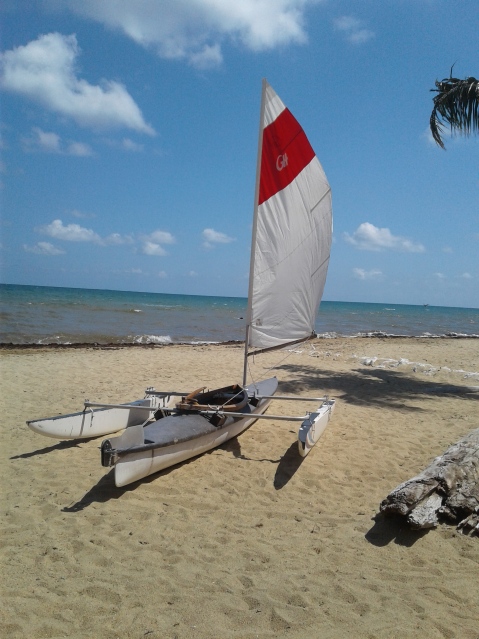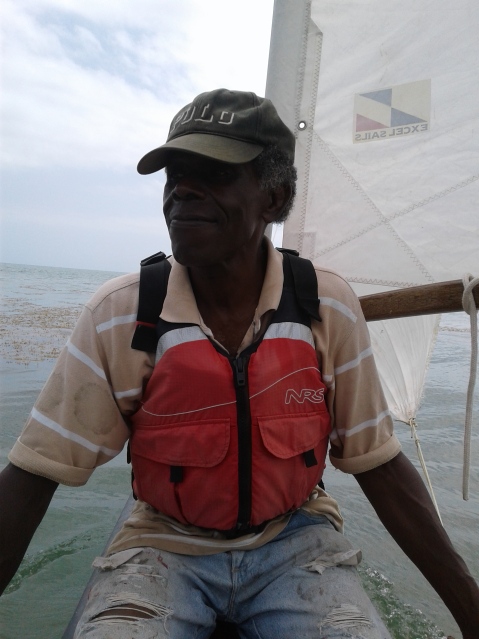Spindrift Floats!
This boat I have been working on for the last, oh, let’s say nine or ten years, in my spare time, while in Belize, has finally reached the point where I could put her in the water and see if she floats, or just keels over and goes down.
I built her myself, from my imagination about how a sailboat should work, but I had a lot of questions:
- How high will she sit in the water? This was a big one, as the first boat I built (Manadi) was so heavy by the time I put on the decking, the outrigger, mast and keel, that she sat so low in the water, I was constantly bailing her. Every little wave would slop a little water over the gunwales. I hauled her out and added a few inches to the freeboard, and that made a big difference.
- Are the outriggers or amas set to the right height? Manadi’s single ama could be adjusted up and down a bit, but Spindrift’s two amas are bolted on. They can be rotated up and out of the way but do not adjust vertically.
- This is the big one: is the keel adequate in size, and is it in the right location? The keel on Spindrift is an old Hobiecat rudder, salvaged on the beach at Half Moon Caye. It is not very wide, but it is deep. My main concern is that it is mounted too far forward.
How do I stop this stupid automatic formatting from inserting a new number every time I hit <enter>? There. Got it. Moving on.
Before I start showing pictures, I just have to warn you that, although she hasn’t been in the water since I paddled her from Belize City after the shipwrecking of Manadi, she has been through a few rainy seasons, had a bit of mud thrown at her, been filled with rainwater a couple of times, in short, she is a bit weatherbeaten.
Here she is on the beach in front of the Island Expeditions ops centre, ready to assemble, and with the amas installed.



Here she is with the main sail in place.

Another angle:

Note the curvature of the starboard-side ama. The amas are made from a wind-surfing board, and so they curve upward at the nose. I installed them facing backwards, as I didn’t want the leading edge to hit the water on an angle, causing undue stress. The leading edge is straight, but low, so it might dip into larger waves. Whether this is a problem we will see.
Now that she is ready to slide into the water, it is time for her first sea trial.
I have a pair of dock fenders, which make perfect rollers. They flatten out a little over the soft sand, and support the boat, rolling more like tank treads than wheels. If they were harder, they might allow sand to build up in front of them making forward motion difficult if not impossible.
The wind was light, from the East, coming straight onto the shore. I was ready.
The boat rolled over the beach and slid into the water. With a big push, I jumped into the cockpit, and picked up a paddle, moving away from the shore. As soon as I was far enough off shore, I pulled in the sheet, and the boat immediately started sailing on a SE course, moving steadily away from shore.

The waves slapped against the windward ama as she picked up speed. I could detect a bit of sideways drift, then remembered to lower the hinged keel. I still need to install a cable that will pull the keel down, so I had to reach over the side and, feeling under the hull, I found the slot the keel rests in. I managed to grab the tip of the keel and hauled her into a vertical position. Immediately the boat ceased sliding sideways and picked up more speed. She began to turn to windward, and I compensated by turning the tiller. With full rudder, she still was turning to windward, and began to stall. I looked back and the rudder was lying almost sideways on the water surface. The wooden transom that the rudder bracket was screwed onto had broken or come loose. This sea trial was over, a mere few hundred metres from shore. Oh well. I expected things might go wrong, as they had with Manadi.
I could not get her to head towards shore. If I hauled in the sheet to sail, the boat would turn into the wind, away from land. If I let out the sheet, I could get her to head towards shore, more or less, but I could only drift. So I picked up the paddle and brought her in the old-fashioned way. I was pleased to learn I could paddle her easily enough, This was another question that I had before I launched: could I comfortably reach the water with a paddle? The answer was yes.
Because the boat has a lot of aluminum, I cannot just leave her on shore or someone might steal her for the scrap value. So I moved down the beach a short distance until I was in front of Dave’s house. Dave is a good friend to Island Expeditions, the kind of guy who couldn’t do enough for you. He gave me permission to store the boat on his parking area right in front of his house.
With a bit of grunting and sweating, I managed to get Spindrift on the crushed stone driveway. I went to Sam’s to get some tools. I then came back and unscrewed the rudder bracket and the removed the wooden piece the bracket was screwed to. Then I took it all over to Sam’s to rebuild it.
It took most of the rest of the day, but I got a new rudder assembly built and and ready to re-install.
The rudder wasn’t the only issue. With the keel so close to the mast, the balance of forces between the sail, the keel and the rudder was way off. The keel and rudder should work together to counter-balance the sail. If the keel is too far aft, the boat will turn away from the wind. This is bad because if the sailor falls overboard, the boat will sail away downwind, leaving the sailor floating in the sea by himself.
If the keel is too far forward, the boat will do what it did: point towards the wind until it stalls. What you want is for the boat to want to turn upwind, but only slightly, so the rudder can correct this tendency. This way, if the sailor falls overboard, the boat will turn into the wind and stall, allowing the sailor to return to his boat. More generally, if you let go of the tiller, the boat turns to windward and stops sailing, so you can do what needs to be done without the boat sailing wildly downwind.
The next day was one of perfect tropical weather. Small cotton-ball clouds scudded slowly in a pale blue sky. An Easterly breeze stirred up a light chop in the green water.
I installed the rebuilt rudder assembly and got the sailing rig ready. This time I added a jib, hopefully to move the center of effort of the sailing rig forward and improve the balance of forces.
All through this project and the one before, I relied on my friend Sam to provide me with space, tools and his occasional help. I had promised him a ride, and wanted to make good on it. Sam doesn’t swim and hasn’t even been in a boat since he was a kid so he was pretty nervous, but he wanted to come for at least a short sail. So when the boat was ready, he came down to the beach. I got him a lifejacket and made sure it was properly fitted to him. He rolled up his jeans (grown men in Belize generally are not keen on wearing shorts, as this is seen as a sign of childhood) and he climbed aboard. I pushed off.
Despite her length, Spindrift is really built for one person. So Sam had to sit on the forward edge of the gunwales, facing backward. He was pretty nervous at first as the boat rolled a bit in the waves, but once we were sailing away, he gained confidence that she wouldn’t just tip over on us. Occasionally a set of larger waves would strike the windward ama and the hull. The boat rocked a bit but showed no sign of instability and he began to relax and have fun.
Dinsdale Sampson, friend, furniture maker and first-time sailor.

I had decided to try the keel again, but this time to lower it only halfway. Since it opened downwards like a pocket knife, I calculated that the halfway-down position would place its center of resistance farther back, and hopefully the smaller amount of exposed keel would be sufficient to reduce lateral drift, and its exposed end would be better located to balance the forces with the sails.
I never found out because the keel was inexplicably jammed in its trunk and would not be coaxed out. So we had to sail without it.
Since the forecast was for light Easterlies all day, I thought it might be fun to sail south, along the coast the nine miles to Hopkins. Hopkins was, not too long ago, a sleepy Garifuna fishing village, but in the last decade or so has become a popular tourist spot. Not too popular yet, it is mostly small family-owned restaurants, beach bars and hotels, scattered among the homes of retired ex-pats from North America and the UK. The beach is the main pedestrian road, and running parallel is a strip of seagrass a short distance from shore. People walk the beach and manatees travel along the seagrass bed.
There is a laid-back vibe here, where Garifuna is heard on the streets, and Rastafarians and hippies mingle with wealthier tourists, divers and fishermen. So I thought it might be fun to sail down to Hopkins, have a pint with the locals and tourists, and then sail back.
We were out maybe an hour when the weather changed. What had been a light E breeze suddenly shifted to the N, and grew in strength. A bank of cloud started to form to the south of us and began expanding in our direction. If we continued on our Southward course, we would have have to beat our way back to Dangriga against the wind in a boat without a keel. Not a good option, so we turned around and headed N again, back to Dangriga. We would run along a tack that pointed us parallel to shore, but we slowly drifted shoreward. When we got too close, we would change tack, and heading due E, we would get in a better position to sail farther N. We were not worried about anything. We would get there in due time. So a distance that took an hour to head south, took three and a half hours to get us home again. But get home we did, before dark, and put the boat away for the time being in Dave’s parking lot.

Now to figure out why the keel won’t come down.

Recent Comments